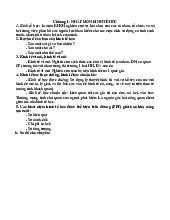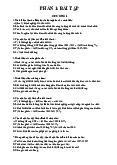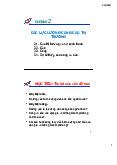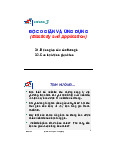








Preview text:
I. What is inflation?( TUYẾT ANH)
1. Definition of inflation
Inflation is a general and ongoing rise in the prices of goods and
services in an economy over time. The purchasing value of money
will decrease because the cost of products and services increases.
So the purchasing power of the consumer will also decline. 2. Cause of inflation
There are 4 main causes of changes in the inflation rate: - Demand-pull inflation- Cos - t push inflation - Inflation
expectations Monetary Inflation
According to this theory, the excessive supply of money in the
market leads to a growth in prices. This cause the prices increases
and the value of money decreases
3. Classification of inflation
There are 3 types of inflation: Moderate inflation. , Galloping inflation 3.3. Hyperinflation
Occurs when the growth in prices is more than three-digit rate
annually. Hyperinflation takes place when there is an unrestricted
growth in the supply of money in the market.
When prices increase rapidly and are unstable, the speed of money
circulation rises quickly, the value of money declines rapidly , and
real wages for workers decrease significantly. => business operations are disrupted. 1
II. Zimbabwe 2008 inflation ( CHÉN NÌ)
1. Overview about Zimbabwe’s 2008 Inflation 1.1 Before inflation
- When the Republic of Zimbabwe declared independence.The
Rhodesian dollar was replaced by the Zimbabwean dollar.
higher exchange rate than the US dollar
- In 1997, Land Reform Program => first move that began to worsen - the economic situation
Involved in the Second Congo War so Robert Mugabe, the
President of Zimbabwe needed cash to spend on his army and pay his army salaries.
1.2. During the inflation
The government responded to rising prices by printing more
money. So the cycle continued, and commodities prices rose.
-They initially printed 1 million Zimbabwe dollars, then increased
the denomination 100 billion dollars in Rhodesia.
- You can see on the slides, in Table 1, the rate of inflation rose dramatically until 2005
- Here is the table price of good during the Zimbabwe Hyberflation:
u can buy a bread with 300 billion dollars
+Citizens become billionaires, but that money is worthless because
basic goods still cost billions of dollars.
2.The Causes of Inflation: there are many reasons for this
- First and foremost is .Land Reform Program - . 2
=> The Land Reform Program resulted in lower agricultural output,
particularly cigarettes, Wheat output, which was 300,000 tons in
1990, fell to 50,000 tons in 2007. 2.2. War funding
- From 1998 to 2002, Participated in the Second Congo War
to help finance the war, Mugabe's government printed more money.
=> deplete most of the monetary reserves
2.3. Government instability
- Being in many conflicts between some countries, for example
+War with the Democratic Republic of the Congo
+Whites and blacks occurred mainly due to the Land Reform Program.
- There is also violence used to repress opposition lawmakers,
weakening trust in the country's political future. 2.4. Unconfident
Conflicts: People and foreign investors are losing faith in the
country's currency as they lose faith in the country's future.
This is primarily due to: Corruption./ Poverty and unemployment
are common/ Higher denominations./ Poor financial decisions. 2.5. Price control
The government wants to keep prices affordable for consumers and prevent rising inflation.
- Impose price controls (price ceilings) on domestic goods and services.
=> As a result, government price controls exacerbated actual shortages and inflation. 3 3. Consequences
3.1. Decreasing the value of savings and retirement money
- Old retirees on fixed incomes are impacted the worst, as their pensions become worthless. 3.2. Unemployment rate
Zimbabwe: unemployment rate from 1999 to 2020
Zimbabwe's unemployment rate, at 95% in 2009, is the highest in
the world, according to the World Factbook. 3.3. Food shortage
- People in Zimbabwe survive by eating at least one meal a day
- In 2013, Zimbabwe had 1.6 million people starving and had
to receive aid from Europe and America
3.4. Average life expectancy decreases (link hình)
. Because of the immediate impact of the food crisis, the
unemployment rate is high, sickness is rampant, and medication is expensive.
FINALLY IS 3.5. Population shift
An estimated 3 million Zimbabweans have left the nation in search of a better life.
Prices for products and services rise faster than earnings and salaries.
People who earn four million Zimbabwe dollars do not spend it
since food prices are so much higher. For example, a sheet of toilet
paper (not a roll) costs $417. 4
4. Measures Zimbabwe applied to overcome the period of hyperinflation: (BÍCH BÙI)
4.2. Control the money supply
The money supply must be regulated ensure that the money
supply does not grow faster than the economy's real output and
matches the productivity of the Zimbabwean economy.
4.3. Attracting foreign investors by eliminating corruption
It is good for the economy of the country because the money
flowing in can create jobs to reduce the unemployment rate.
A country with a safe environment will attract foreign direct
investment and increase confidence in its future.
The country also needs the contribution of the international
community. China and neighboring African countries are some
possible candidates to pour money into. Zimbabwe must find a
mutually beneficial arrangement
III. Venezuela inflation
1. Overview about Venezuela 2008 inflation (BÍCH BÙI)
1.1. Before the inflation.
Venezuela has the world's greatest oil reserves, but due to its
reliance on oil exports, its economy has been in a recession, which
turned into a crisis when global oil prices fell in 2014. 5
1.2 During the inflation.
+ In terms of ecomomy: The sharp drop in oil prices led to a serious
devaluation of the foreign currency of country A. Ohur himself has
to print more money and borrow from abroad + In term
s of social: People fall into poverty, do not have money to
buy food, medical treatment. Crime rate is alarmingly high. 2
of Inflation (BÍCH BÙI)
2.1.The tension between government and domestic enterprises
Government control over the money market gives
multinational companies significant advantages over domestic
enterprises. This led to a dramatic increase in prices due to a lack
of goods and price abuse in the illegal distribution network. 2.2 Oil prices
=> However, due to its reliance on oil, Venezuela entered a serious
crisis when the price of crude oil fell from 2014 to 2019. 2.3. The debt
The rest of the world is owed more than $50 billion by Venezuela.
This would not be an issue if they owed 50 billion bolivars because
the Venezuelan government has the ability to produce all the
bolivars required to settle their debts. But the debt of Venezuela is
a dollar debt. This causes the bolivar to depreciate in the foreign
exchange market because no one needs that much of it.
2.4. Policy Bolivarian missions
Instead of adjusting fiscal policies through tax increases and
spending cuts, the Maduro government tried to solve the growing
budget deficit by printing money 6
=========> As a result, a formula for hyperinflation is simple:
Foreign debt + weak government + massive money printing = hyperinflation
=========> In short, the underlying cause of inflation in
Venezuela is cost-push inflation and currency inflation 7
3. Consequences. (M.Nhật)
3.1. Economic recession
The Economist stated at the end of October 2017 that Venezuela's
overall debt had reached 105 billion (USD),
3.2. Humanitarian crisis
People are suffering from severe shortages of milk, beef, poultry,
pre-processed flour, coffee, butter, and other basics such as medicine and hygiene
( A person in Venezuela is sitting and eating food from a garbage dump.) 3.3. Unemployment rate
The graph shows Venezuela's unemployment rate from 2010 to 2019
=> affects not only the millions of Venezuelan workers currently
below the poverty line but also their families.
3.4.Political recession
4. Measures were taken by the Government of Venezuela (MINH NHẬT)
4.1. Limit printing more money and change monetary policy
The government adjusted monetary policy to encourage "belief" in
the Bolivarian currency when it began to actively intervene in the
value of the currency: On August 20, the government decided to issue a new banknote. 8
4.2. Unleash exchange rates in financial markets
Venezuela decided to apply free currency conversion across the
country, expanding its currency management system
=> promote the production of the country
4.3. Adjusting fiscal policy
The state has set a fiscal deficit target of zero. Establish
prepayments for income taxes and taxes for large financial
transactions From 2016 to 2018, corporate taxes and other taxes are
estimated to average more than 20% of the GDP.
4.4.Concentrate on politics
Venezuela applies open economic policies, accepts the use of US
dollars in civil transactions, suppresses corruption, and quells
dissidents. The Venezuelan government is trying to ask the US to lift economic sanctions 9




